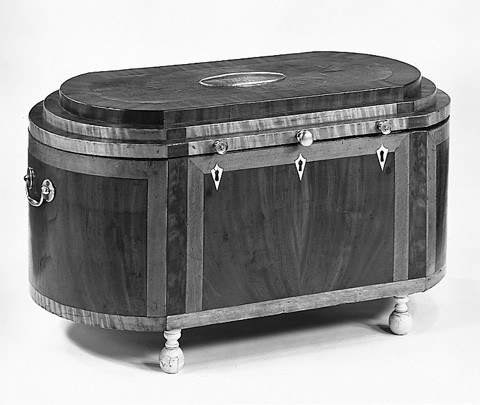
Coffer for the Hermann Benevolent Brotherhood, Philadelphia, 1816. Mahogany, maple, and cherry with yellow poplar. H. 41 5/16", W. 77 3/16", D. 41 5/16". (Courtesy, Yale University Art Gallery, Mabel Brady Garvan Collection.)

Leaf no. 77 showing toy furniture from a trade catalogue, possibly G. G. Fendler and Company, Nuremburg, Germany, 1830–1840. Hand-colored lithograph. (Courtesy, Winterthur Museum Library.)
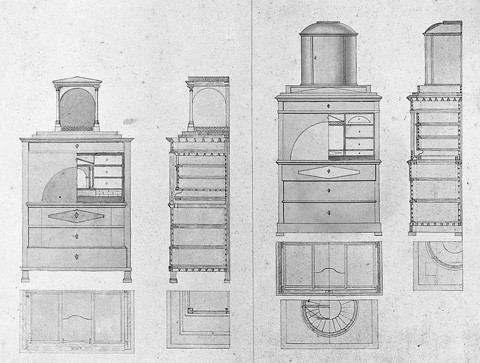
Designs for fall-front secretaries by Frederick Gutekunst, Sr. (1801–1890), Württemberg, Germany, 1828. Ink and ink wash on paper. (Courtesy, Athenaeum of Philadelphia.) This sheet is one of fourteen brought to Philadelphia by Gutekunst in 1831. The images are variously dated from 1825 to 1828.

Fall-front secretary with musical works attributed to Johann Gottfried Kaufmann (1751–1818), Dresden, Germany, ca. 1804. Burled veneer with basswood; marble, paint, and gilded bronze. H. 84", W. 33 1/4", D. 20 1/8". (Stephen Girard Collection, Girard College, Philadelphia; photo, Gavin Ashworth.)
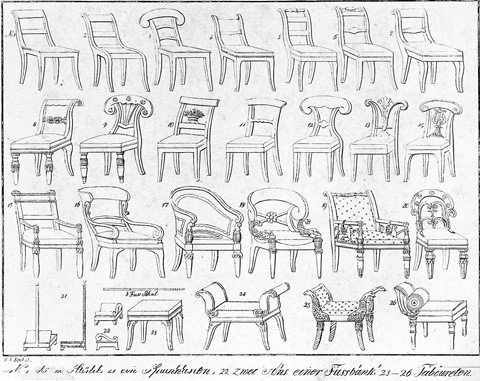
Designs for chairs and other furniture illustrated on plate 1 from G. J. Lipp, Meubles-Zeichnungen für Tischler (Berlin, 1835). (Courtesy, Winterthur Museum Library.)
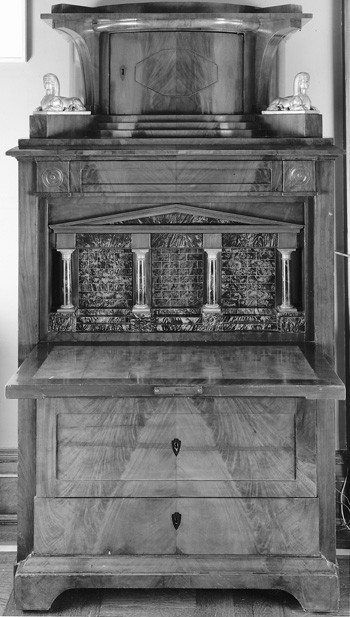
Fall-front secretary, Germany, 1820–1835. Mahogany with oak, pine, and basswood; gilding, pewter inlay, and gilded bronze. H. 72", W. 40 3/4", D. 20 1/4". (Private collection; photo, Gavin Ashworth.)
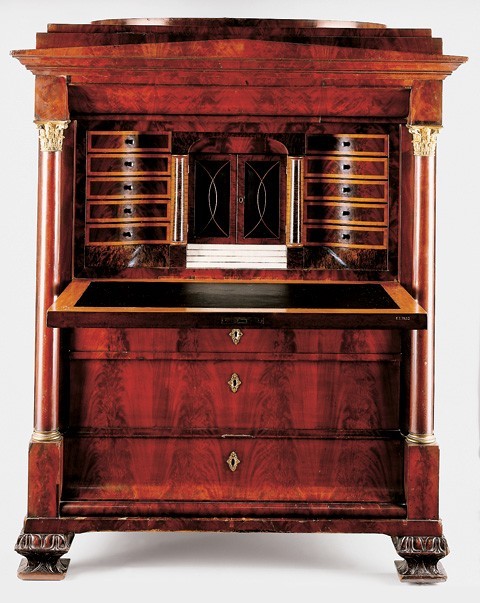
Fall-front secretary, Philadelphia, 1820–1830. Mahogany and rosewood with pine, yellow poplar, and chestnut; gilded bronze. H. 61", W. 49 3/4", D. 26 1/2". (Smithsonian Institution, Washington, D.C.; photo, Gavin Ashworth.)
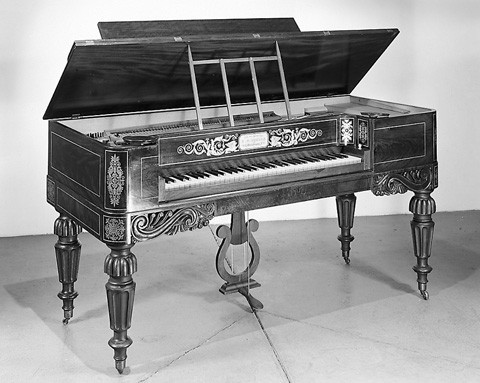
Pianoforte by Emilius N. Scherr (1794–1874), Philadelphia, ca. 1830. Mahogany with unrecorded secondary woods; ivory and basemetals. H. 36", W. 68", D. 28". (Courtesy, Philadelphia Museum of Art, gift of Mrs. George L. Rush.)
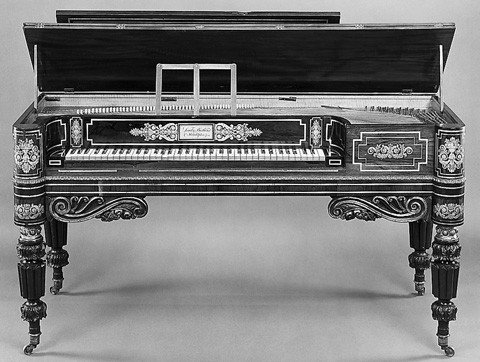
Pianoforte by Loud & Brothers (fl. 1825–1833), Philadelphia, ca. 1830. Mahogany with unrecorded secondary woods; ivory and basemetals. W. 68 5/16". (Courtesy, The Metropolitan Museum of Art, The Crosby Brown Collecton of Musical Instruments, 1889 (89.4.2812) Photograph ©The Metropolitan Museum of Art.)
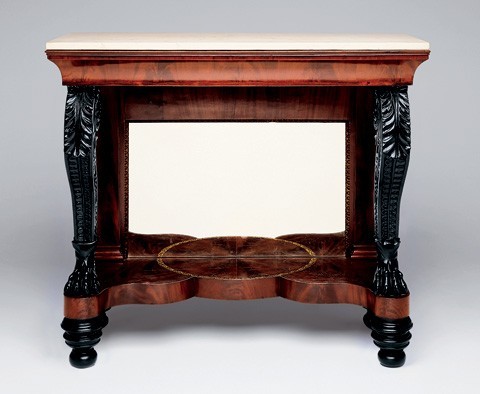
Pier table attributed to Anthony Quervelle, Philadelphia, ca. 1830. Mahogany with yellow poplar, white pine, and yellow pine; marble and glass. H. 37 1/2", W. 41", D. 30". (Courtesy, Dallas Museum of Art, Faith P. and Charles L. Bybee Collection, gift of Mr. and Mrs. Willard E. Brown, III—The Bolton Foundation, Governor and Mrs. William P. Clements, Jr., Mr. and Mrs. Gerald C. Johansen, George and Schatzie Lee, Mr. Irving L. Levy, Mr. and Mrs. Ronald L. McCutchin, the Stanley and Linda Marcus Foundation, Mr. Frederick R. Mayer, and the Frederick M. Mayer Memorial Fund.)
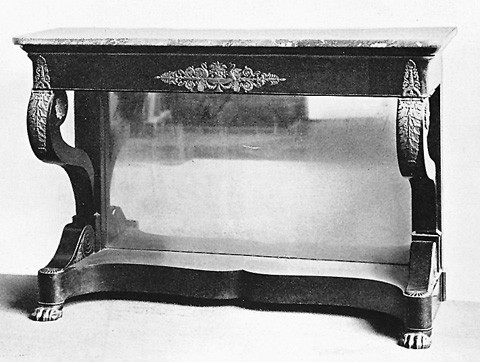
Pier table, southern Germany, 1820–1830. Materials and dimensions not recorded. (Former collection of L. Brenheimer, Munich, Germany; image from Hermann Schmitz, Deutsche Möbel des Klassizismus [Stuttgart: Hoffmann, 1923], p. 202.)
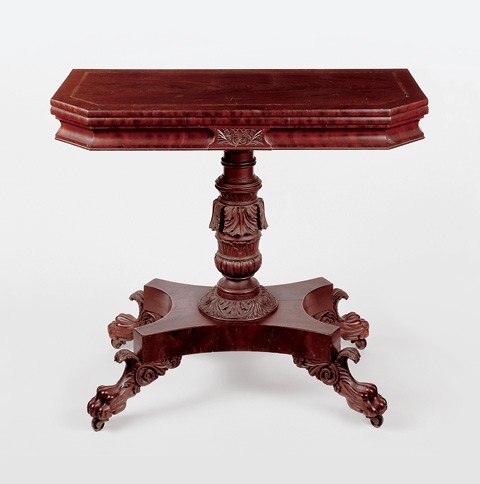
Card table by Anthony Quervelle (1789–1856), Philadelphia, 1830–1840. Mahogany with unrecorded secondary woods. H. 29 3/4", W. 36 7/8", D. 18 1/2". (Private collection; photo, Gavin Ashworth.) This table bears Quervelle’s label for his 126 South Second Street shop. He was active there between 1829 and 1849.

Card table, possibly Altona, Germany, ca. 1830–1835. Mahogany. Secondary woods and dimensions not recorded. (Courtesy, Städtisches Museum, Flensburg, Germany.)
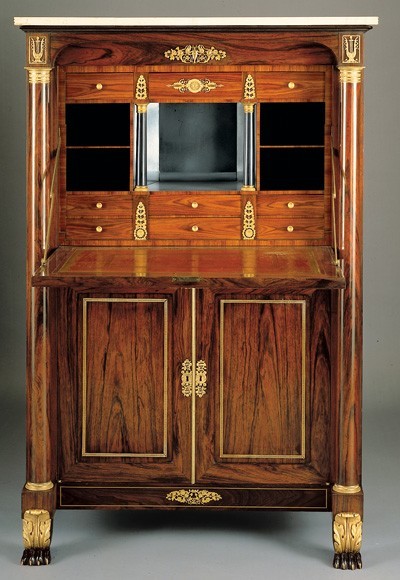
Fall-front secretary, Philadelphia, 1815–1830. Rosewood with pine and tulip poplar; marble, gilding, paint, brass, and gilded bronze. H. 60", W. 40", D. 19". (Private collection; photo, Sotheby’s.)
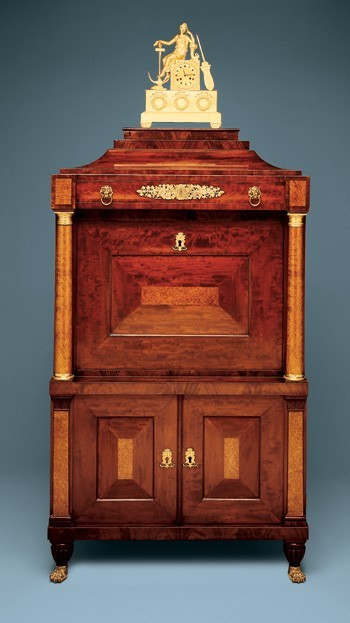
Fall-front secretary, Philadelphia, 1815–1830. Mahogany, hard maple, ebony, and cherry with yellow poplar and eastern white pine; gilded bronze. H. 62 7/8", W. 35 7/8", D. 21 1/8". (Courtesy, Dallas Museum of Art, Faith P. and Charles L. Bybee Collection, anonymous gift in memory of Frederick Miller Mayer; photo, Tom Jenkins.)
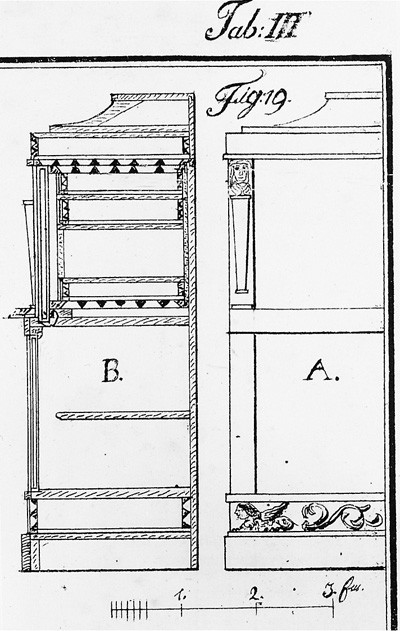
Design for a fall-front secretary illustrated on plate 3, figure 19 of Marius Wölfer, Der Bau- und Meubel-Schreiner, eine bildliche Anweisung zur antiken und moderne Architecktur (Illmenau, Germany, 1828). (Courtesy, The Metropolitan Museum of Art, Thomas J. Watson Library.)
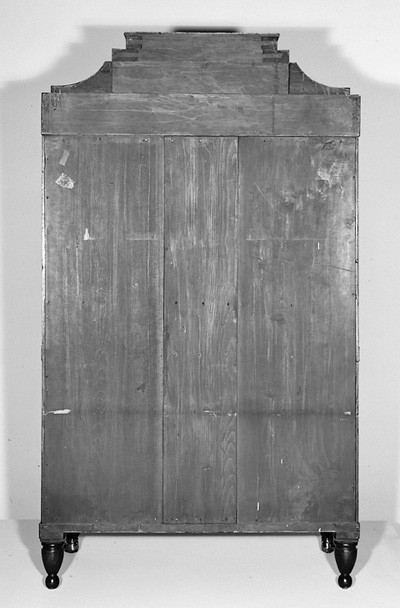
Rear view of the fall-front secretary illustrated in fig. 15.
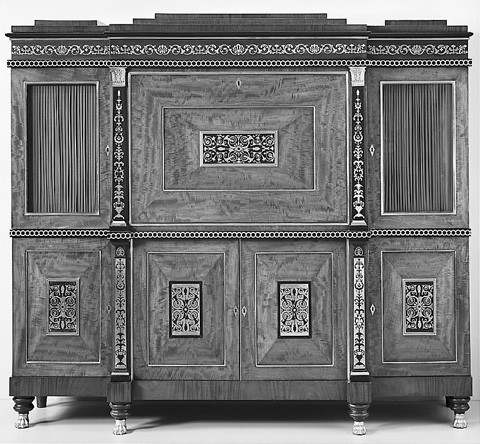
Fall-front secretary with wings, Philadelphia, 1817–1825. Mahogany with white pine and tulip poplar; ebony, brass, and glass. H. 63 3/4", W. 73 3/4", D. 28 1/2". (Philadelphia Museum of Art, donated by Simon Gratz in memory of Caroline S. Gratz; photo, Eric Mitchell.)
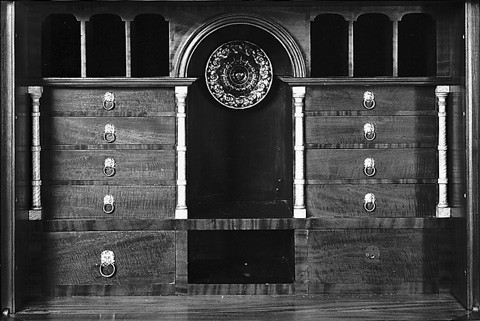
Interior view of the fall-front secretary illustrated in fig. 18.

Interior view of the fall-front secretary illustrated in fig. 15.
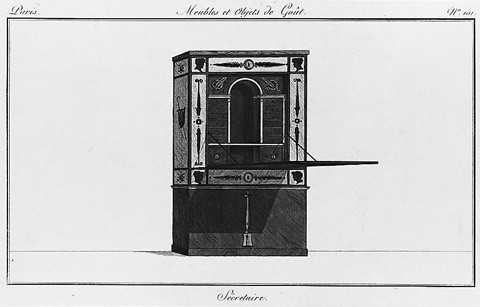
Design for a fall-front secretary illustrated on plate 101 of Pierre de la Mésangère, Collections des Meubles et Objects de Goût (Paris, 1804). (Courtesy, Winterthur Museum Library.)
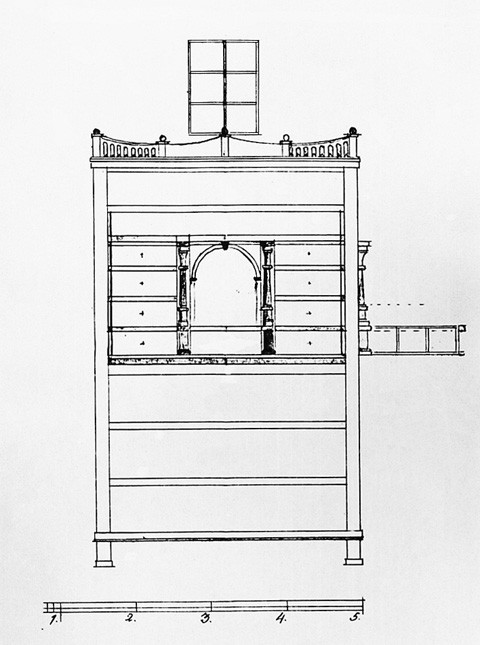
Design for a fall-front secretary by Joseph Fiedler, Württemberg, Germany, 1800–1810. Ink on paper. (Courtesy, Historical Society of York County, York, Pennsylvania; photo, Charles Venable.)

Fall-front secretary, Philadelphia, 1815–1830. Mahogany and maple with yellow poplar and pine; gilded bronze. H. 65", W. 43 1/2", D. 21 3/4". (Courtesy, Athenaeum of Philadelphia; photo, Gavin Ashworth.)

Work table, Philadelphia, 1820–1840. Mahogany with ash and other unidentified secondary woods. Dimensions not recorded. (Courtesy, Antiques.)
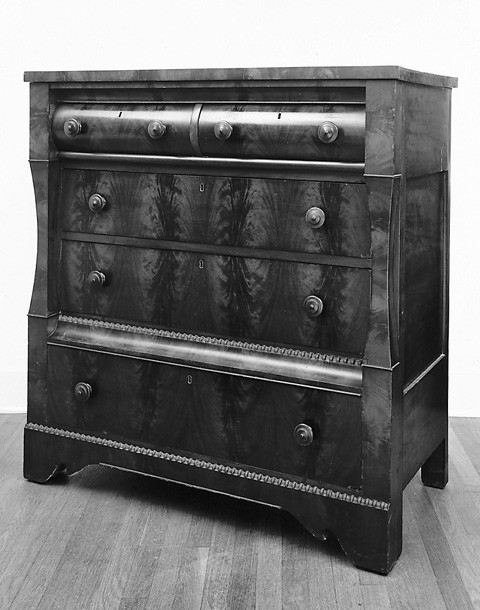
Chest of drawers, Philadelphia, ca. 1840. Mahogany with pine and yellow poplar. H. 45 1/2", W. 43 1/2", D. 20 3/4". (Private collection; photo, Tom Jenkins.) The chest is inscribed: “Bought from the / D. Pine Estate of Whitford, Pa. / by Justen Warren (?) / West Chester, Pa. / March 1912”.
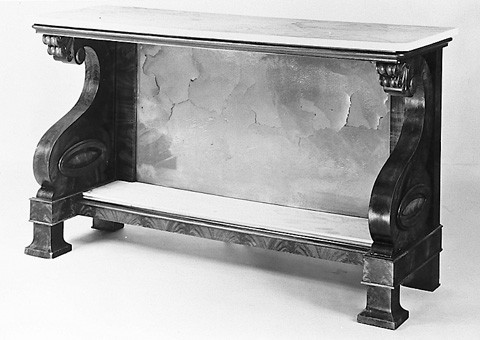
Pier table, Philadelphia, 1830–1840. Mahogany and unidentified secondary woods; marble and glass. Dimensions not recorded. (Courtesy, Decorative Arts Reference Library, Winterthur Museum.)
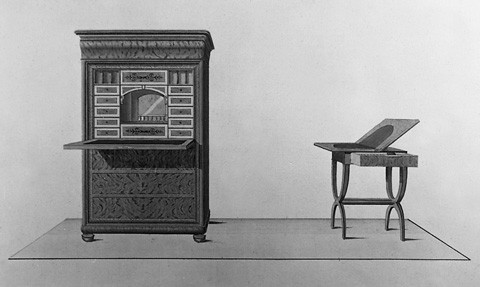
Design for a fall-front secretary (1837) illustrated on plate 2 of Wilhelm Kimbel, Journal für Möbelschreiner und Tapezierer, vol. 1 (Mainz, 1835–1853). (Courtesy, Cooper-Hewitt, National Museum of Design.)
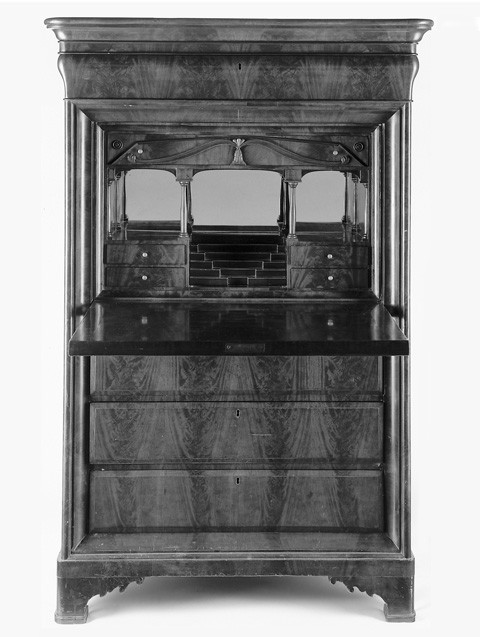
Fall-front secretary, probably Philadelphia, 1835–1850. Mahogany with yellow poplar; glass. H. 65 1/2", W. 42 3/4", D. 22 1/4". (Courtesy, Historical Society of York County, York, Pennsylvania; photo, Gavin Ashworth.)
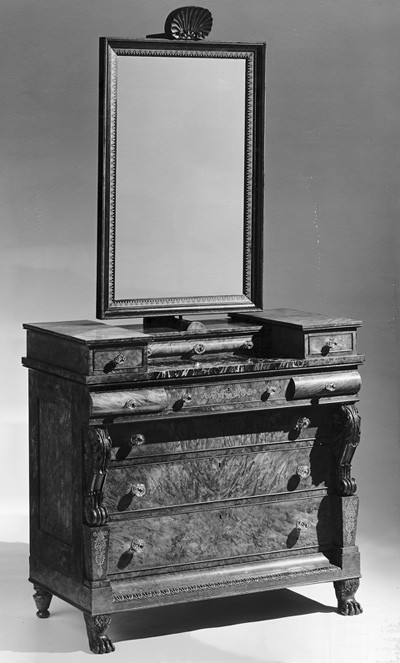
Dressing bureau made by Walter Pennery in John Jameson’s workshop, Philadelphia, 1830. Maple with tulip poplar; glass, brass, and iron. H. 87 3/8", W. 43 3/8", D. 24 1/2". (Courtesy, Winterthur Museum.) The bureau is inscribed: “The year of our lord one thousand eight hundred / and thirty / Philadelphia June 11th 1830 / Walter Pennery”.
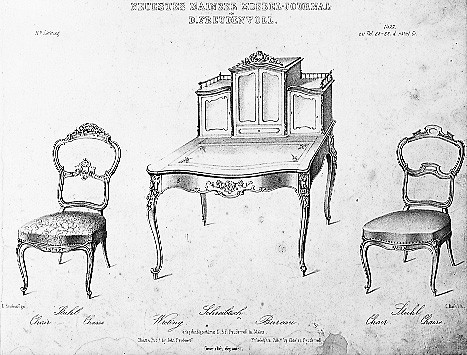
Design for a desk and chairs illustrated on plate 11 of D. Freudenvoll, Neuestes Mainzer Moebel-Journal (Mainz, 1846–n.d.). (Courtesy, Athenaeum of Philadelphia.)

Sofa, New York City, ca. 1849–1850. Rosewood with ash. H. 43", W. 74", D. 34". (Courtesy, Dallas Museum of Art, gift of the Friends of Decorative Art; photo, Tom Jenkins.) The back is constructed from seven layers of laminated wood. The newspaper fragments found in this sofa are dated 1849.

Advertisement for Charles H. L. Goehmann (d. 1866) on page 27 of O’Briens Philadelphia Wholesale Business Directory (Philadelphia, 1850). (Photo, Charles Venable.) Goehmann is listed in Philadelphia directories from 1849 to 1866. He was at the 15th Street address noted here in 1850 and 1851. He was well known for his fancy twist work, for which he was cited by the Franklin Institute in 1844.
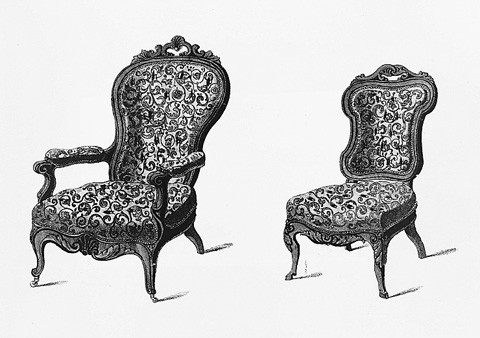
Designs for chairs illustrated on plate 3 of J. W. Hanke, Neues Journal für Möbelschreiner (Frankfurt am Main, 1841). (Courtesy, Winterthur Museum Library.)

Designs for fall-front secretaries illustrated on plate 12 of D. Freudenvoll, Neuestes Mainzer Moebel-Journal (Mainz, 1846–n.d.). (Courtesy, Athenaeum of Philadelphia.)
